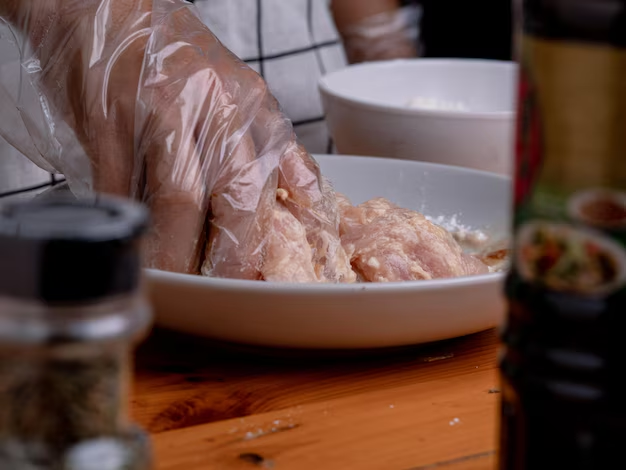How Long Is Cooked Chicken Good In The Fridge? Find Out Here!
You're in the kitchen, contemplating what to make for lunch, when you remember that delicious roasted chicken you cooked on Sunday. But wait, how long has it been stashed away in the fridge? Deciphering the shelf life of cooked chicken can sometimes feel as complex as solving a Rubik's cube. How long does cooked chicken stay good in the refrigerator? Let’s sort through the experts’ tips and essential guidelines, so you don’t have to second-guess your next meal.
🕰️ Understanding Cooked Chicken Shelf Life
The Golden 3- to 4-Day Rule
Cooked chicken generally stays fresh for 3 to 4 days when properly stored in the refrigerator. This window is more than a guideline; it's a golden rule many food safety experts agree upon. After this period, the likelihood of spoilage and bacterial growth significantly increases, posing a risk to your health.
Factors Affecting Shelf Life
While the 3- to 4-day benchmark is a reliable rule, several factors can alter this timeframe:
- Storage Temperature: Refrigeration at or below 40°F (4°C) is essential.
- Storage Method: Air-tight containers or well-sealed wraps are a must.
- Initial Cooking Conditions: Fully cooked through to a safe internal temperature.
🥡 Proper Storage Techniques
Cool It Down Quickly
Post-cooking, ensure that the chicken is cooled and refrigerated within two hours. This quick cool-down helps prevent bacterial proliferation commonly linked to illnesses.
Seal It Right
Use air-tight glass or plastic containers. Alternatively, tightly wrapped aluminum foil or plastic wrap can also suffice. Proper sealing prevents bacteria and helps retain moisture and flavor.
Labeling and Tracking
For those prone to forgetting, consider labeling the storage container with the date the chicken was cooked. This simple habit helps keep track of freshness and reduces the risk of spoilage.
🐔 Recognizing Spoiled Chicken
The Tell-Tale Signs
There are clear indicators when cooked chicken is no longer safe to enjoy:
- Odor: A sour or ammonia-like smell is a red flag.
- Texture: Slimy or sticky surfaces mean it's time to toss.
- Color: A change to a dull or grey tone signals spoilage.
Trust Your Senses
When in doubt, trust your senses. If something seems off, it's best to err on the side of caution and discard it. Eating spoiled chicken can lead to food poisoning, which is far worse than losing a meal.
🥗 Creative Ways to Use Leftover Chicken
Delicious Transformations
Reimagine your cooked chicken within that safe timeframe by employing it in other tasty dishes. Here are a few ideas to inspire you:
- Chicken Salad: Mix with mayonnaise, celery, and grapes for a delightful sandwich filler.
- Tacos: Shred chicken into tacos with fresh salsa and avocado.
- Hearty Soups and Stews: Add to soups for extra protein.
Storage Solutions for Extended Life
If you find yourself with more chicken than you can consume in a few days, consider freezing. Doing so halts bacterial growth, extending shelf life for up to 3 months.
- Freezing Tips: Portion the chicken, wrap each section in freezer-safe wraps or bags, and label with the date.
📝 Quick Storage & Safety Summary
Here’s a handy table to keep your fridge safety tips fresh in your mind!
| Reminder 🗓️ | Key Tips & Insights ✔️ |
|---|---|
| Cool Quickly | Refrigerate within 2 hours of cooking. |
| Proper Sealing | Use air-tight containers or wraps. |
| Label Wisely | Include the cooking date to track shelf life. |
| Trust Your Senses 👃 | Bad odors, texture, or color = discard! |
| Freeze Friendly ❄️ | Safe for up to 3 months in the freezer. |
👩🍳 Tips for Roasting and Storing
Getting It Right From The Start
Cooking the chicken properly is critical. Ensure that your chicken reaches an internal temperature of 165°F (74°C) to eliminate harmful bacteria from the get-go.
Smart Roasting Practices
- Preheat Your Oven: Ensure the oven is up to temperature before the chicken goes in.
- Don’t Overcrowd: Gaps allow heat to circulate evenly.
Storage Do's and Don'ts
- Do: Use smaller portions to cool faster.
- Don't: Repeatedly reheat only what's needed to prevent repeated exposure to temperature fluctuations that can lead to spoilage.
📚 Understanding Refrigeration Science
The Role of Temperature
Refrigeration slows bacterial growth. Keeping your fridge at or below 40°F prevents the proliferation of pathogens like Salmonella and E. coli that can thrive in warmer environments.
Consistent Checks
- Invest in a Fridge Thermometer: This ensures your appliance is operating at a safe temperature.
- Routine Cleanliness: A tidy, odor-free fridge minimizes cross-contamination.
🤔 Final Insights on Cooked Chicken Storage
Ensuring the safety of your cooked chicken is just as crucial as perfecting its flavor during preparation. Proper storage, timely cooling, and keen observation should become a wholesome routine, safeguarding you and your loved ones from potential risks. Regular habits of checking storage conditions and planning meals around what’s available also help in making the most out of your grocery haul, minimizing waste while ensuring food safety.
By following these guidelines, you guarantee safe meals that remain delightfully tasty, meal after meal. So, prep that chicken with confidence, knowing you’ve mastered the art of safe food storage! 🐔✨
